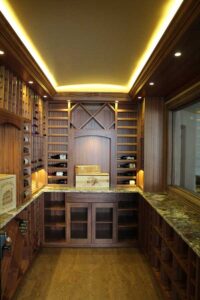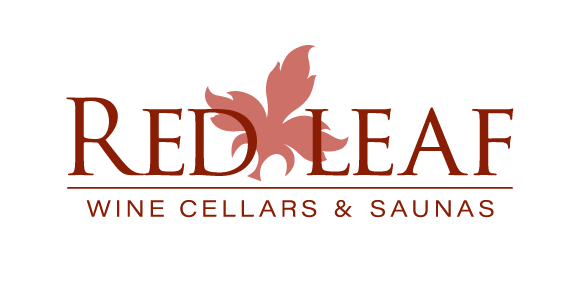Basement Wine Cellar Design
With over 20 years of experience, Red Leaf Solutions LLC has earned a reputation for excellence by helping wine enthusiasts to create their own dream wine cellars. When it comes to wine storage, the basement offers an ideal location due to its naturally cool and consistent temperature. In this article, our goal is to provide readers with a comprehensive guide on designing a basement wine cellar that is functional, visually appealing, and suitable for their collections.

Assessing the Space
Before starting a wine cellar design project, you need to assess the basement space thoroughly. Considerations such as temperature and humidity control, insulation, lighting, and ventilation should be taken into account. Basements often have more stable temperatures compared to other parts of the house, but it’s essential to ensure proper insulation to maintain optimal conditions for wine storage. Additionally, installing an efficient cooling system and monitoring humidity levels will help to preserve the quality of your wines.
Planning & Design
The planning and design phase is critical for a successful wine cellar project. Start by setting a budget and establishing a design concept that aligns with your personal style and preferences. Determine the capacity and layout of the wine cellar, considering factors such as the size of your collection and available space. Proper shelving and organization systems are essential to maximize storage capacity and ease of access to your bottles.
Temperature and Humidity Control
Temperature and humidity play a crucial role in preserving the quality of wines. The ideal temperature for long-term storage is between 55°F and 59°F with humidity levels around 60-70%. There are various cooling systems available, including self-contained units, ducted systems, and split systems, each with its advantages and disadvantages. Regular monitoring and maintenance are necessary to ensure the cellar’s temperature and humidity levels remain within the desired range.
Lighting and Décor
Lighting is not only crucial for creating the desired ambiance in a wine cellar, but it also plays a functional role in showcasing your collection. LED fixtures and accent lights are popular choices as they emit minimal heat and do not affect temperature control. When it comes to décor, consider the flooring, wall finishes, and artwork that will complement the overall aesthetic of the space.
Wine Racks and Storage Solutions
Investing in proper wine racks and storage solutions is vital to keep your collection organized and secure. Various types of wine racks are available, including wood, metal, or modular systems. Consider factors such as bottle capacity, ease of access, and aesthetic appeal when selecting the right wine racks for your cellar. Customizable options are often recommended such as locks and access control systems to restrict access to authorized individuals. Surveillance systems or alarms can also be incorporated for added security and peace of mind.
Wine Cellar Maintenance and Organization.
Maintaining a well-functioning wine cellar requires regular attention and care. Implement a cleaning routine to keep the space dust-free and ensure wine bottles are stored in optimal conditions. Regularly rotate your wines to prevent sedimentation and maintain their quality. Establish an inventory management system and use proper labeling and cataloging techniques to easily locate and track your wines.
Showcasing the Wine Cellar
A wine cellar isn’t just a storage space. It can also serve as a stunning showcase for your collection. Consider incorporating a tasting area, seating, or even a wine bar to create a comfortable and inviting space for enjoying your wines. Glass walls or viewing windows can provide an elegant touch, allowing guests to admire your collection while maintaining proper temperature and humidity control.
Summary
Designing a basement wine cellar requires careful planning and consideration of various factors, including temperature control, storage solutions, lighting, security, and maintenance. Red Leaf Solutions has the expertise and experience to assist you in creating your dream wine cellar.
At Red Leaf Solutions, we aim to create captivating wine cellars that enhance our clients’ homes. Our vision is to design beautiful custom cellars while ensuring the ideal storage conditions for fine wines. We strive to improve the wine drinking experience by expertly crafting cellars that impress guests with exquisite wines. Our comprehensive services include planning, designing, and building wine cellars from start to finish. Whether you’re integrating a cellar into a new home or updating your current one, we provide meticulous attention to detail and collaborate with you to bring your ideas to life. Let us transform your space with a stunning custom wine cellar.
For more information about our services, schedule a consultation, contact us via our website, or give us a call at 720-307-0284.
